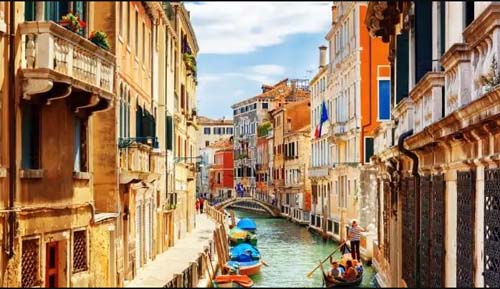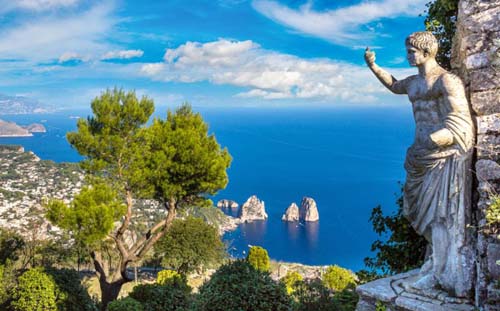What does traveling to Italy look like in 2022

Rome: It’s no secret that the pandemic threw a massive wrench into the travel industry–for better and for worse. While limiting and restricting international travel has been a means of trying to control the spread of covid-19, the tourism industry, and the countless cities and countries it supports, have suffered.
Near the top of the list is Italy, a country whose economy relies heavily on tourism. Countless would-be travelers and tourists to Italy postponed their travels plans in 2020 and 2021. Now, as the world trudges into year three of the pandemic, many are wondering: What about now? Should I visit Italy in 2022? And given the current pandemic-related restrictions, is Italy worth visiting in 2022?
Since 1999, tourism and travel in Italy have accounted for between 10 to 15 percent of the national total gross domestic product (GDP)–a significant portion of the nation’s income. According to Statista, since 2010, that number had been rising steadily. But in 2020, it dropped to only 7 percent. Such a dramatic shift in tourism and travel-related activity has had a massive negative economic impact– Italy brought in over 100 billion euros less in 2020 than in 2019. There had been hope for recovery in 2021, but new Covid-19 variants and subsequent restrictions caused a second year of severe economic losses.

“The pandemic was devastating for our sector,” says Antonio Barreca, the General Director of Federturismo, the Italian Association of Travel and Tourism Industry, “but also for the transport sector and all of the chains that serve the tourism industry, such as food and beverage and fashion… The impact was huge. We estimated 150 billion euros in damages between 2020 and 2021.”
There was a partial rebound in tourism in 2021 from domestic tourism that wasn’t able to travel abroad, but the year ended with an estimated 50 to 80 percent loss. For tourism operators, Barreca says, that number was up to 90 percent.
Compared to the United States, whose state-by-state mask-mandates and gathering restrictions vary in severity but are more or less followed based on individual judgment, and the United Kingdom, where Covid-19 restrictions were recently lifted, Italy’s current mandates may sound strict. Surgical masks or FFP2 masks (the Italian equivalent of KN95 and N95) are required indoors and in congested outdoor public spaces.
Many businesses have capacity limits, and a person must show proof of recent vaccination or a recent booster in the form of an official international vaccination card, an Italian “Super Green Pass,” or proof of a recent negative Covid test before entering most establishments and tourist sites. However, some of these restrictions are slowly on their way out.
On 23 February, the Italian government announced that Covid-19 mandates and travel restrictions will be eased beginning on March 1, creating a true sense of hope for the tourism industry. Most drastically, as of March 1, vaccinated non-European travelers will be able to enter Italy without providing a negative Covid test, as long as they are vaccinated with one of the EU-approved vaccines.
Unvaccinated individuals or individuals vaccinated with non-EU approved vaccines must provide proof of a negative Covid-19 test or a certificate of recent recovery upon entry, but will no longer be required to quarantine. While indoor mask mandates will remain in place, the Super Green Pass system will slowly be phased out. So far, there are no concrete dates on the timeline of the phase-out. The official end of Italy’s state of emergency is 31 March.

According to Antonio Barreca, the General Director of Federturismo, for those in the tourism sector, spring/summer 2022 is the light at the end of the pandemic tunnel. He describes that, according to new internal market studies from the United States, Italy is currently the top travel destination for people from the United States, Germany, and Australia.
“We’re hoping for a comeback in 2022–bigger than 2019,” he says. “People have been saving money for the past two years, so now they’re ready to come back and spend it.”
Barreca calls this phenomenon “Revenge tourism” — people resent the good times the pandemic prevented them from having, and now that things (finally) seem to be returning to normal, people are ready to go out and have the time of their lives. Young tourists are expected to be at the forefront of this movement, making up the first wave of tourists to reach Italy in 2022, while older people remain wary of Covid.
The tourism sector also expects a drastic shift in the culture of tourism. In 2022, people are more attentive to the quality and depth of their time and experiences, having spent so much time indoors and secluded during the pandemic. Instead of focusing on traditional sightseeing experiences, experts in the tourism industry anticipate that tourists in 2022 will also seek out rich, unique experiences. Small villages, Borghi, are going to be central to this shift.
“This new type of tourist will be more attentive to the quality of the service and experience–more interested in visiting new experiences, lesser-known places, small villages–looking for an ‘authentic’ tourism experience,” says Barreca.
Despite the easing of Covid-19 restrictions, Covid-19 prevention will remain central to tourism companies and facilities. The International Organization for Standardization (ISO) outlines specific protocols for different types of organizations, from businesses to transportation systems. “We’ve invested a lot of money into these protocols,” says Barreca. “It was very hard work. Each category needs specific protocols–what works for a hotel doesn’t work for a train.”
Barreca, like Italians across all economic sectors, is excited about the return of tourism in Italy. Not only will it bring economic rehabilitation, but it will also bring a renewed sense of excitement and energy to the country at large–something that many Italians have missed since pre-pandemic days.
“After two years,” Barreca says, “we are very excited.”
The lack of tourism in Italy from 2020 to 2021 transformed the landscapes of many traditionally tourism-driven cities. In a surreal twist surprising to anyone who visited a heavily-touristed Italian city pre-pandemic, Italy today seems, quite frankly, Italian. As of February 2022, there is still an overwhelming sense in restaurants, shops, and busy piazzas, that the majority of people are Italian.
For example, at busy tourist sites in Rome, such as the Colosseum, the Roman Forum, and the Trevi Fountain, Romans and Italians from other cities and regions have returned to appreciate the stunning monuments previously crowded by international tourists. Before tourism season takes off in May 2022, travelers have the opportunity to experience Italy alongside the Italians–while helping contribute to economic rehabilitation.
Before coming traveling to Rome for a quick vacation in January 2022, Joya Lawrence, a Seattle-based bartender and kitchen supervisor, was worried that Italy’s Covid-19 restrictions might negatively affect her trip. Instead, upon arriving in Italy, she was pleasantly surprised by how safe she felt.
“I found it really responsible,” she says. “In a way, it was more lenient than I thought. Of course, you have to wear a mask and show your vaccination card, but since I had those things, I found it really responsible.”
It was a stark contrast to her life back in Seattle, where she feels many people don’t take Covid-19 seriously. After returning to the U.S., she was more concerned about catching Covid-19 from visiting one of her friends than she had been during her entire vacation in Rome.
Despite Italy’s mask mandate and the Super Green Pass system, Lawrence enjoyed her 2022 trip more than a previous pre-Covid visit to Rome.
“I felt less like a tourist and more like an observer,” she says. “Like I was going not for a quick visit but that I could take my time with things.”
She didn’t feel the familiar touristic pressure to visit popular sites on “off days” to avoid crowds–there were no big crowds. She visited the Sistine Chapel on a Saturday, and was able to follow along with a Rick Steves’ Travel Guide that suggested she experience the Chapel from the center “if possible.” When she visited the Aventine Keyhole, a popular tourist site that normally amasses a lengthy line of tourists every day, she only had to wait behind two other people before taking her turn.
The only hiccup on Lawrence’s trip came as a result of her American vaccination card. She and her friend were turned away from a restaurant because they did not have digital proof of vaccination with a QR code. European vaccination passes, such as Italian Green and Super Passes, have a scannable QR code that contains a person’s vaccine information. While most restaurants and establishments accept official CDC-verified American vaccination cards in lieu of a QR code, some (rare) establishments only accept digital proof. Just in case, American tourists may want to call establishments in advance or check their online Covid-19 regulations to be sure.
Lawrence recommends visiting Italy in 2022 to those who are respectful, responsible, and interested in getting an up-close taste of the art, culture, and history: “You can do everything you want to do,” she says, “just be responsible.”





